215 Charles Street, West End
The Charles Street Jail opened in 1851 as a facility that housed arrestees awaiting trial within Suffolk County. The building employed a reform-minded style which allowed for natural light and ventilation within the structure to provide an adequate quality of life for inmates. Over its many decades of existence, the jail held not only those accused of common crimes, but also many arrested for political reasons—including numerous women who demonstrated support for the suffrage amendment by protesting President Woodrow Wilson’s visit to Boston in 1919. Its better-known prisoners included Malcolm Little (Malcolm X), Nicola Sacco and Bartolomeo Vanzetti, Boston Mayor James Michael Curley, prisoners from two German U-boats during World War I, and William R. Baird Jr., a birth control activist.

In 1971, inmates sued the Suffolk County Sheriff and the Massachusetts Commissioner of Corrections for a violation of their constitutional rights due to the overcrowding in the jail. Federal Judge W. Arthur Garrity, best known for his desegregation decision (1974) in the Boston Public Schools, spent the night in the jail in 1973. His experience led him to declare the jail’s conditions unconstitutional and to order its closing. It wasn’t until 1990, however, that the jail closed and the prisoners were transferred to a new facility, the Suffolk County Jail, on Nashua Street.
What was the Charles Street Jail is now part of the Liberty Hotel, a luxury hotel owned by Massachusetts General Hospital and a site on the National Registry of Historic Places. The ironically named facility is centered around the jail’s circular rotunda surrounded by several levels of catwalks that used to connect the jail cells to one another; they now act as hallways between guestrooms, meeting rooms, and the hotel’s high-end restaurants and bars—ones with names such as Clink and the Alibi.

Getting there:
Red Line to Charles/MGH Station. The site is across the street from the station.
To learn more:
“Liberty Hotel History.” The Liberty Hotel: A Luxury Collection Hotel, Boston.
Inmates of Suffolk County Jail v. J Kearney. 928 F 2d 33 (1991).
Walton, Krista. “Free at Last: A remarkable restoration transformed Boston’s notorious Charles Street Jail into the sparkling Liberty Hotel.” Preservation (September/October 2009).
Photo credit:
The photo, titled “Entrance to Suffolk County Jail,” at the top of the entry is from September 11, 1964. Source: Brearley Collection, Arts Department, Boston Public Library, via Digital Commonwealth.



